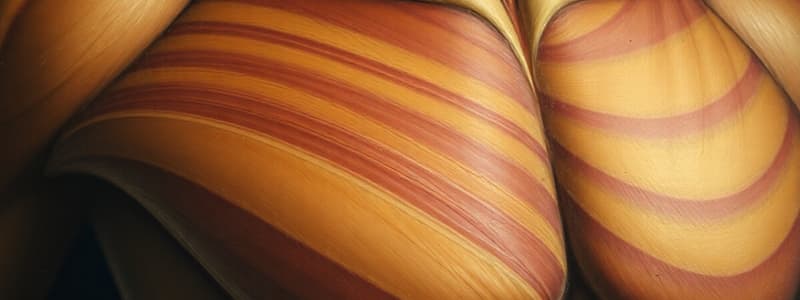Podcast
Questions and Answers
Which of the following sites does not contain skeletal muscle?
Which of the following sites does not contain skeletal muscle?
- Diaphragm
- Skeletal structures
- Small intestine (correct)
- Upper 2/3 of the esophagus
Which of these areas is primarily associated with control of voluntary movements?
Which of these areas is primarily associated with control of voluntary movements?
- Heart
- Pharynx (correct)
- Smooth muscle in arteries
- Diaphragm
What is the primary function of skeletal muscle in the diaphragm?
What is the primary function of skeletal muscle in the diaphragm?
- Facial expression
- Swallowing
- Movement of the eyes
- Respiration (correct)
Which muscle group would be affected by nerve signals for facial expressions?
Which muscle group would be affected by nerve signals for facial expressions?
Which statement accurately describes the location of skeletal muscle?
Which statement accurately describes the location of skeletal muscle?
What is the typical shape of the cremasteric muscle?
What is the typical shape of the cremasteric muscle?
What describes the sarcolemma of the cremasteric muscle?
What describes the sarcolemma of the cremasteric muscle?
In which areas is the cremasteric muscle's shape different from its typical form?
In which areas is the cremasteric muscle's shape different from its typical form?
Which of the following statements about the cremasteric muscle is false?
Which of the following statements about the cremasteric muscle is false?
What characteristic of the cremasteric muscle distinguishes it from other muscles?
What characteristic of the cremasteric muscle distinguishes it from other muscles?
What best describes the nucleus of muscle fibers?
What best describes the nucleus of muscle fibers?
What is the origin of muscle fibers?
What is the origin of muscle fibers?
What role do satellite cells play in muscle fibers?
What role do satellite cells play in muscle fibers?
Which term refers to the connective tissue surrounding the entire muscle?
Which term refers to the connective tissue surrounding the entire muscle?
What does the perimysium do in muscle fiber organization?
What does the perimysium do in muscle fiber organization?
What is the cytoplasm of a muscle fiber referred to as?
What is the cytoplasm of a muscle fiber referred to as?
Which characteristic distinguishes skeletal and cardiac muscles from smooth muscle?
Which characteristic distinguishes skeletal and cardiac muscles from smooth muscle?
What term is used to describe the membrane surrounding a muscle fiber?
What term is used to describe the membrane surrounding a muscle fiber?
Which of the following organelles is NOT commonly found in the sarcoplasm of muscle fibers?
Which of the following organelles is NOT commonly found in the sarcoplasm of muscle fibers?
Which component of muscle fibers is responsible for calcium storage?
Which component of muscle fibers is responsible for calcium storage?
Which type of muscle has a thick sarcolemma?
Which type of muscle has a thick sarcolemma?
What type of regeneration occurs in smooth muscle tissue after injury?
What type of regeneration occurs in smooth muscle tissue after injury?
Which feature distinguishes skeletal muscle from smooth muscle?
Which feature distinguishes skeletal muscle from smooth muscle?
Smooth muscle cells are typically arranged in what pattern?
Smooth muscle cells are typically arranged in what pattern?
What is a defining characteristic of skeletal muscle tissue?
What is a defining characteristic of skeletal muscle tissue?
Flashcards are hidden until you start studying
Study Notes
Muscular Tissue
- Muscular tissue originates from mesoderm
- The functional unit of muscle tissue is the muscle fiber, a modified cell
- Sarcolemma is the cell membrane of a muscle fiber
- Sarcoplasm is the cytoplasm of a muscle fiber
- Sarcoplasm is acidophilic and contains all organelles, especially mitochondria, smooth endoplasmic reticulum, and inclusions (fat, glycogen and myoglobin)
- Smooth endoplasmic reticulum in muscle fibers is called sarcoplasmic reticulum
- Muscle fibers can be striated (skeletal and cardiac) or unstriated (smooth)
Skeletal Muscle
- Skeletal muscle is found in the skeleton, face, eyes, tongue, pharynx, upper 2/3 of esophagus, diaphragm, and cremasteric muscle
- Skeletal muscle fibers are cylindrical and non-branching except in the face and tongue
- Skeletal muscle fibers have a clear and thick sarcolemma
- Skeletal muscle fibers have multiple, peripheral, and oval nuclei
- Skeletal muscle fibers originate from the fusion of mononucleated myoblasts
- Skeletal muscle fibers can regenerate from satellite cells
- Skeletal muscle fibers are organized in a hierarchical way:
- Epimysium surrounds the entire muscle
- Perimysium surrounds bundles of muscle fibers
- Endomysium surrounds individual muscle fibers
- Skeletal muscle is voluntary with the exception of the pharynx, upper 2/3 of esophagus, diaphragm, and cremasteric muscle, which are involuntary
Smooth Muscle
- Smooth muscle is found in organs and blood vessels
- Smooth muscle fibers are fusiform and arranged in layers
- Smooth muscle fibers have a thin sarcolemma
- Smooth muscle fibers have acidophilic sarcoplasm except for dark patches called dense bodies
- Smooth muscle fibers have a single central oval nucleus
- Smooth muscle originates from undifferentiated mesenchymal cells (UMCs)
- Smooth muscle regenerates after injury through mitosis of UMCs and pericytes
Comparison Between Skeletal and Smooth Muscle
- Site: Skeleton versus Organs
- Shape: Cylindrical versus Spindle
- Size: Largest versus Smallest
- Sarcolemma: Thick versus Thin
- Nucleus: Multiple and peripheral versus Single and central
- Striations: Present versus Not present
- Regeneration: Satellite cells versus UMCs
- Tubular system: Triad versus Not present
Studying That Suits You
Use AI to generate personalized quizzes and flashcards to suit your learning preferences.



